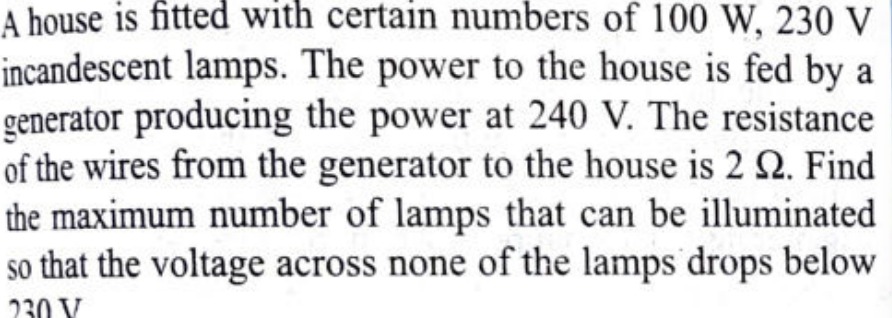Question
Question: A house is fitted with certain numbers of 100 W, 230 V incandescent lamps. The power to the house is...
A house is fitted with certain numbers of 100 W, 230 V incandescent lamps. The power to the house is fed by a generator producing the power at 240 V. The resistance of the wires from the generator to the house is 2 Ω. Find the maximum number of lamps that can be illuminated so that the voltage across none of the lamps drops below 230 V.

11
Solution
-
Calculate the resistance of a single lamp: The power rating of each incandescent lamp is P=100 W at V=230 V. Using the formula P=V2/R, the resistance of one lamp (Rlamp) is: Rlamp=PV2=100 W(230 V)2=10052900=529 Ω.
-
Determine the equivalent resistance of 'n' lamps in parallel: When 'n' identical lamps are connected in parallel, their equivalent resistance (Rp) is: Rp=nRlamp=n529 Ω.
-
Calculate the total resistance of the circuit: The total resistance (Rtotal) includes the resistance of the wires (Rwires=2 Ω) and the equivalent resistance of the lamps: Rtotal=Rwires+Rp=2+n529 Ω.
-
Calculate the total current drawn from the generator: The generator produces a voltage of Vgen=240 V. The total current (Itotal) is given by Ohm's Law: Itotal=RtotalVgen=2+n529240 A.
-
Calculate the voltage drop across the wires: The voltage drop across the wires is: Vdrop_wires=Itotal×Rwires=(2+n529240)×2=2+n529480 V.
-
Determine the voltage across the lamps: The voltage across the parallel combination of lamps (Vlamps) is the generator voltage minus the voltage drop across the wires: Vlamps=Vgen−Vdrop_wires=240−2+n529480 V.
-
Apply the condition for the voltage across the lamps: The problem states that the voltage across none of the lamps should drop below 230 V. Since the lamps are in parallel, they all have the same voltage. Thus, we require Vlamps≥230 V. 240−2+n529480≥230.
-
Solve the inequality for 'n': 240−230≥2+n529480 10≥2+n529480 Since 2+n529 must be positive, we can multiply both sides: 10(2+n529)≥480 20+n5290≥480 n5290≥480−20 n5290≥460 Since n must be positive, we can rearrange: n≤4605290 n≤46529 n≤11.5.
-
Find the maximum integer value for 'n': Since the number of lamps must be an integer, the maximum number of lamps that can be illuminated without the voltage dropping below 230 V is the greatest integer less than or equal to 11.5. Maximum n=11.
